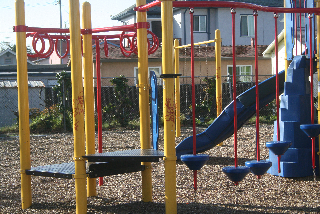
All across California, school districts are hammering out contracts with city agencies to split the costs and responsibilities of opening their gates to the public after hours.
In Rancho Cordova, a suburban city east of Sacramento, a park district official says she can count on one hand the number of public recreational facilities the city owns. But local residents can use school baseball fields, tracks, courts, and more, thanks to agreements with several area school districts.
In San Francisco, a pilot project recently unlocked playgrounds and blacktops at 11 public schools on weekends and holidays – the first step in an ongoing partnership between the school district and local government to open access to play spaces throughout the city.
And in the high desert city of Adelanto in San Bernardino County, there is no parks department because the city has so few recreational facilities – but thanks to a new partnership between the city and the school district, an empty five-acre field next to a school was just transformed into a park that’s open to the entire community after school hours.
We’ve never needed safe play spaces more than we do now. About a third of children in California – and two-thirds of adults – are overweight or obese. Many are urged to get more exercise but can’t follow this advice very easily where they live. Children compete with speeding cars as they try to walk or bike to school. Safe parks and playgrounds are often few and far between, especially in low-income communities.
Schools, of course, have all kinds of exercise facilities – indoor gyms, soccer fields, tracks, basketball courts, even swimming pools. But when the school day ends, these spaces are often locked to students and the rest of the neighborhood.
School districts have reasons for keeping these spaces closed after hours. They’re concerned about security. They’re afraid of getting sued if someone gets hurt. They can’t afford to pay for extra maintenance.
But communities throughout California are resolving these issues through what’s known as a joint use agreement: a written contract spelling out a formal arrangement that lets the partners – often a school district and a city agency – share the costs and responsibilities of shared access to property. Although many communities informally agree to share facilities, a well-crafted formal joint use agreement can help make sure the process goes smoothly.
Creating a successful joint use agreement isn’t easy: it takes a lot of work and cooperation, and it can require some effort to reach agreement on the issues involved. Here are some important things to consider in producing a successful agreement, from coordinating scheduling and staffing to handling maintenance and the possibility of injury.
• Identify needs at the outset. What neighborhoods are in the greatest need of recreational opportunities? What types of facilities would best meet those needs, and what locations would be most convenient?
• Build relationships with the right decision-makers. Identify school board members, city council members, and other public officials who support the idea, and work with them to get other community leaders on board with the initiative.
• Establish the scope of an agreement. What facilities should be included? Consider operational and management issues: Who will oversee scheduling for each facility? Will security or other supervision be necessary? Who will be responsible for maintenance and repairs?
• Work with risk management and legal counsel on liability and other legal issues. Allocate liability risk among the agreement’s partners, and determine whether and what type of indemnification to require. Determine any types of insurance the partners will need, and how much.
• Develop a protocol for communication. One of the most important elements of a successful joint use agreement is making sure that all parties communicate effectively during its term. Establish a way for identified employees to talk regularly about the agreement, and set up a process for resolving disagreements.
These agreements aren’t always easy to negotiate and carry out. But with careful planning and ongoing collaboration, they can go a long way toward providing safe, convenient opportunities for exercise in neighborhoods with few other options.
For more resources on agreements opening school property to the public, see www.unlockpossibilities.org.
Robert S. Ogilvie is a program director at Public Health Law & Policy, a research and training center based in Oakland.





